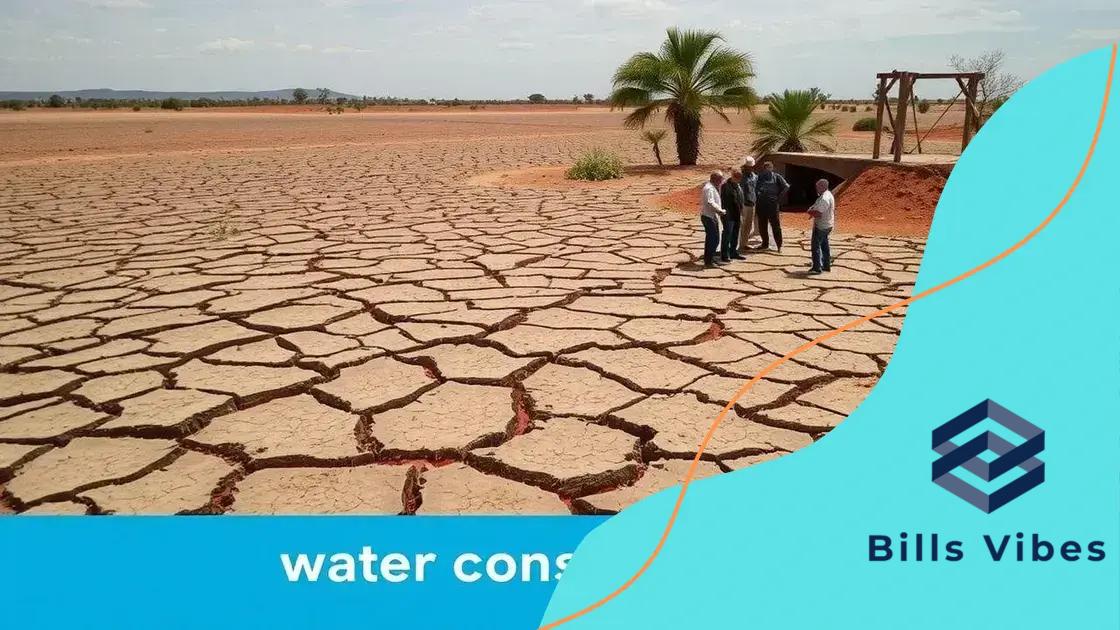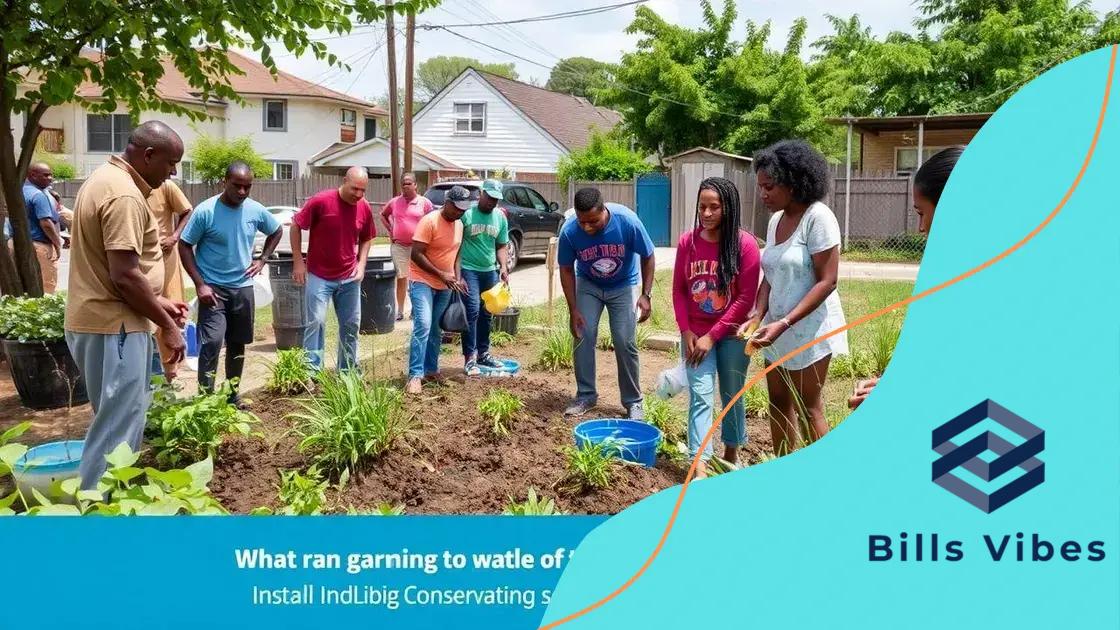Water scarcity solutions: practical approaches for everyone

Water scarcity solutions involve community engagement, innovative technologies, and government policies that promote conservation and sustainable management of water resources to address the critical challenges posed by limited water availability.
Water scarcity solutions are becoming increasingly important in our changing climate. Have you ever thought about how limited water resources affect your daily life? Let’s dive into practical ways we can address this pressing issue together.
Understanding water scarcity
Understanding water scarcity is a critical step in addressing our planet’s limited water resources. Water scarcity affects millions globally and can lead to severe social and environmental issues. It is essential to comprehend why water becomes scarce and how we can tackle this problem.
What causes water scarcity?
There are several reasons why communities face water scarcity. Some of the primary factors include:
- Climate change, leading to unpredictable weather patterns and decreased rainfall.
- Population growth increasing the demand for water.
- Pollution that contaminates water sources.
- Overuse of groundwater resources.
As these factors contribute to increased pressure on our water supplies, understanding them becomes crucial for effective management. Identifying the causes can help us formulate better strategies to conserve water.
Impacts of water scarcity
The impacts of water scarcity are far-reaching. Communities without enough water can face:
- Health problems due to lack of clean drinking water.
- Decreased agricultural productivity, which affects food security.
- Economic struggles as industries reliant on water suffer.
- Social conflicts over limited resources, leading to instability.
These factors highlight the significance of addressing water scarcity. The solutions we pursue depend on our understanding of these impacts and the urgency to respond. Knowledge is the first step towards action.
When we comprehend the challenges posed by water scarcity, we are better equipped to support initiatives that help mitigate these issues. Engaging with communities on water conservation practices can pave the way for a more sustainable future.
Innovative technologies for water conservation
Innovative technologies for water conservation are helping communities around the world tackle the growing challenge of water scarcity. These advancements allow us to use water more efficiently and responsibly, ensuring a sustainable future.
Smart irrigation systems
One of the most effective technologies is smart irrigation. These systems optimize water use for agriculture, minimizing waste. By using sensors to monitor soil moisture levels, farmers can:
- Water crops only when necessary.
- Adjust watering schedules based on weather conditions.
- Reduce overall water consumption significantly.
This technology not only conserves water but also improves crop yield and reduces costs for farmers.
Rainwater harvesting
Another innovative approach is rainwater harvesting. This method captures and stores rainwater for later use. Here are the benefits of implementing such systems:
- Reduces dependency on treated water sources.
- Helps manage stormwater runoff effectively.
- Can be used for irrigation, toilet flushing, and more.
By collecting rainwater, communities can enhance their resilience against water scarcity and decrease their water bills.
Advanced filtration technologies also play a crucial role in water conservation. By purifying water from various sources, these systems make it safe for drinking and irrigation. They can help communities reuse wastewater, contributing to a circular water economy.
Overall, the role of innovative technologies in conserving water is profound. As we embrace these solutions, we can look forward to a more sustainable approach to water management and a brighter future in battling water scarcity.
Community-driven solutions to manage water resources

Community-driven solutions to manage water resources are gaining traction worldwide. These initiatives empower local populations to take action, ensuring sustainable water use and conservation.
Importance of community involvement
When communities are directly involved in managing their water resources, they tend to develop a stronger commitment to conservation. Local residents understand the challenges they face, which enables them to create tailored solutions. Some benefits of community involvement include:
- Enhanced awareness of water issues.
- Increased participation in conservation efforts.
- Better alignment of resources with community needs.
- Greater resilience against climate change effects.
This active participation fosters a sense of ownership and responsibility, leading to more effective water management.
Examples of community-led initiatives
Various community-driven solutions have successfully improved local water management. For instance, rain gardens and bioswales are designed to capture and infiltrate rainwater, which reduces runoff and enhances water quality. Additionally, some communities have organized water committees that oversee local water sources, enabling residents to cooperate and share best practices.
Another effective approach is water conservation education programs. These initiatives empower community members with knowledge about saving water at home and in their gardens. By sharing tips and techniques, communities can significantly reduce their water consumption.
Furthermore, local advocacy groups often work together to influence policies, ensuring that water management reflects the community’s needs. These efforts can lead to better investment in infrastructure and promote sustainable practices among businesses and residents alike. Stronger community ties are built through these collaborations, ultimately leading to long-lasting benefits for both people and their water resources.
The role of education in water scarcity solutions
The role of education in water scarcity solutions is vital for fostering awareness and promoting sustainable practices. Education empowers individuals and communities to understand the importance of water conservation and encourages action.
Raising awareness
Education programs focused on water scarcity teach people about the challenges our planet faces. When communities learn about the impact of climate change and population growth on water resources, they become more informed. Strategies that focus on:
- Understanding the sources of water scarcity.
- Identifying ways to conserve water at home.
- Learning about water recycling and reuse.
These programs help raise awareness about the need for proactive measures to tackle water issues.
Encouraging community involvement
Education plays a crucial role in motivating community members to participate in water conservation initiatives. Schools and local organizations can create programs that bring people together to:
- Participate in clean-up events near water bodies.
- Install rainwater harvesting systems in homes.
- Engage in workshops to learn about efficient irrigation techniques.
Such hands-on experiences not only enhance understanding but also foster a sense of responsibility toward the environment.
Additionally, integrating water education into school curriculums can shape future generations’ attitudes toward water conservation. Students learn the significance of preserving this resource, enabling them to make informed choices as adults. Education that emphasizes sustainable practices ensures a better future for our water sources.
As communities become more knowledgeable about water scarcity solutions, collaborative efforts grow stronger. When individuals recognize their role in conservation, collective action becomes the norm. Understanding the importance of education leads to more sustainable and effective responses to the water scarcity crisis.
Government policies and their impact on water management
Government policies and their impact on water management play a crucial role in how effectively water resources are conserved and utilized. By implementing well-structured policies, governments can promote sustainable practices and ensure equitable access to water.
Regulating water usage
One significant aspect of water management is the regulation of water usage. Governments establish rules that dictate how much water can be used by agricultural, industrial, and residential users. These regulations can:
- Help prevent over-extraction of water sources.
- Ensure fair distribution among different sectors.
- Encourage conservation methods.
Effective regulations can also include incentives for reducing water waste and adopting sustainable practices.
Funding water initiatives
In addition to regulations, government funding is vital for developing water management initiatives. Investments can be made in technologies that promote efficient water use. These initiatives may involve:
- Support for advanced irrigation technologies.
- Grant programs for community water conservation projects.
- Funding for research on water recycling and treatment methods.
When governments allocate resources to these efforts, communities benefit directly through improved water management systems.
Moreover, public awareness campaigns funded by the government can educate citizens about water conservation. This education promotes responsible water use, leading to better outcomes in water management overall.
Governments also play an essential role in international agreements about shared water resources. By collaborating with neighboring countries, they can address challenges related to rivers, lakes, and aquifers that cross borders.
Ultimately, the policies put in place by governments shape how communities utilize and manage their water resources. Effective legislation can lead to a more sustainable future, reducing the impacts of water scarcity and ensuring that everyone has access to this vital resource.
FAQ – Frequently Asked Questions about Water Scarcity Solutions
What are the main causes of water scarcity?
The main causes of water scarcity include climate change, increasing population, water pollution, and over-extraction of water resources.
How can communities contribute to water conservation?
Communities can engage in local projects, participate in educational programs, and implement water-saving technologies to reduce water usage.
What role does government policy play in managing water resources?
Government policy helps regulate water usage, fund conservation initiatives, and promote public awareness about water management.
What innovative technologies are available to save water?
Some innovative technologies include smart irrigation systems, rainwater harvesting, and advanced filtration methods that improve water efficiency.






